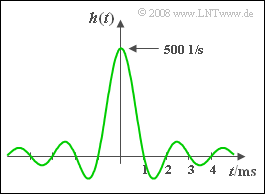Exercise 1.5Z: Sinc-shaped Impulse Response
From LNTwww
The impulse response of a linear time-invariant (and non-causal) system was determined as follows (see graph):
- $$h(t) = 500\hspace{0.1cm}{ {\rm s}}^{-1}\cdot{\rm sinc}\big[{t}/({ 1\hspace{0.1cm}{\rm ms}})\big] .$$
The output signals $y(t)$ should be computed if various cosine oscillations of different frequency $f_0$ are applied to the input:
- $$x(t) = 4\hspace{0.05cm}{\rm V}\cdot {\rm cos}(2\pi \cdot f_0 \cdot t ) .$$
Please note:
- The exercise belongs to the chapter Some Low-Pass Functions in Systems Theory.
- The solution can be found in the time domain or in the frequency domain. In the sample solution you will find both approaches.
- The following definite integral is given:
- $$\int_{ 0 }^{ \infty } \frac{\sin(u) \cdot \cos(a \cdot u)}{u} \hspace{0.15cm}{\rm d}u = \left\{ \begin{array}{c} \pi/2 \\ \pi/4 \\ 0 \\ \end{array} \right.\quad \quad \begin{array}{c} {\rm{f\ddot{u}r}} \\ {\rm{f\ddot{u}r}} \\ {\rm{f\ddot{u}r}} \\ \end{array}\begin{array}{*{20}c}{ |a| < 1,} \\{ |a| = 1,} \\ { |a| > 1.} \\ \end{array}$$
Questions
Solution
(1) A comparison with the equations on the page [[Linear_and_Time_Invariant_Systems/Some_Low-Pass_Functions_in_Systems_Theory#Ideal_low-pass_filter_–_Rectangular-in-frequency
|Ideal low-pass filter]] or applying the inverse Fourier transformation shows that $H(f)$ is an ideal low-pass filter:
- $$H(f) = \left\{ \begin{array}{c} \hspace{0.25cm}K \\ K/2 \\ 0 \\ \end{array} \right.\quad \quad \begin{array}{*{10}c} {\rm{f\ddot{u}r}} \\ {\rm{f\ddot{u}r}} \\ {\rm{f\ddot{u}r}} \\ \end{array}\begin{array}{*{20}c} {\left| \hspace{0.005cm} f\hspace{0.05cm} \right| < \Delta f/2,} \\ {\left| \hspace{0.005cm}f\hspace{0.05cm} \right| = \Delta f/2,} \\ {\left|\hspace{0.005cm} f \hspace{0.05cm} \right| > \Delta f/2.} \\ \end{array}$$
- The equidistant zero-crossings of the impulse response occur at an interval of $Δt = 1 \ \rm ms$ .
- From this it follows that the equivalent bandwidth is $Δf \rm \underline{ = 1 \ \rm kHz}$.
- If $K = 1$ was true, then $h(0) = Δf = 1000 \cdot \rm 1/s$ should hold.
- Because of the given $h(0) = 500 \cdot{\rm 1/s} = Δf/2$ the direct signal (DC) transmission factor thus is $K = H(f = 0) \; \rm \underline{= 0.5}$.
(2) This problem is most easily solved in the spectral domain.
- For the output spectrum the following holds: $Y(f) = X(f)\cdot H(f) .$
- $X(f)$ consists of two Dirac functions at $± f_0$ each with weight $A_x/2 =2 \hspace{0.08cm}\rm V$.
- For $f = f_0 = 1 \ {\rm kHz} > Δf/2$ , however $H(f) = 0$ holds, such that $Y(f) = 0$ and hence also $y(t) = 0$ ⇒ $\underline{y(t = 0) = 0}$.
The solution in the time domain is based on convolution:
- $$y(t) = x (t) * h (t) = \int_{ - \infty }^{ + \infty } {h ( \tau )} \cdot x ( {t - \tau } ) \hspace{0.1cm}{\rm d}\tau.$$
- At time $t = 0$ the following is obtained considering the symmetry of the cosine function:
- $$y(t = 0 ) = \frac{A_x \cdot \Delta f}{2} \cdot \int_{ - \infty }^{ + \infty } {\rm si} ( \pi \cdot \Delta f \cdot \tau ) \cdot {\rm cos}(2\pi \cdot f_0 \cdot \tau ) \hspace{0.1cm}{\rm d}\tau.$$
- With the substitution $u = π · Δf · τ$ , this can also be formulated as follows:
- $$y(t = 0 ) = \frac{A_x }{\pi} \cdot \int_{ 0 }^{ \infty } \frac{\sin(u) \cdot \cos(a \cdot u)}{u} \hspace{0.15cm}{\rm d}u .$$
- Here, the constant is $a = 2f_0/Δf = 2$. With this value, the given integral yields zero: $y(t = 0 ) = {A_y } = 0.$
(3) The frequency response has the value $K = 0.5$ at $f = f_0 = 100 \ \rm Hz$ according to the calculations for subtask (1) . Therefore,
- $$A_y = A_x/2 = 2\ \rm V$$ is obtained.
- The same result is obtained by convolution according to the above equation.
- For $a = 2f_0/Δf = 0.2$ the integral is equal to $π/2$ and one obtains
- $$y(t = 0 ) = {A_y } = \frac{A_x}{\pi} \cdot \frac{\pi}{2} = \frac{A_x}{2} \hspace{0.15cm}\underline{= 2\,{\rm V}}.$$
(4) The transition from the band-pass to the band-stop is exactly at $f = 0.5 \ \rm kHz$ and for this singular location the following holds:
- $$H(f = f_0) = K/2.$$
- Thus, the amplitude of the output signal is only half as large as calculated in subtask (3) , namely $A_y \; \underline{= 1 \, \rm V}$.
- The same result is obtained with $a = 2f_0/Δf = 1$ by convolution.
